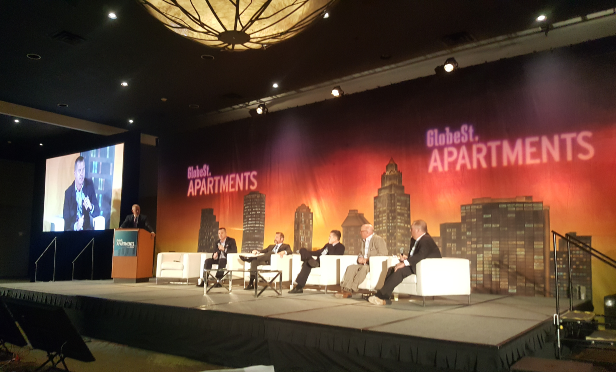 Value-add investment opportunities are becoming more challenging, and some investors that once focused solely on value-add investment are now looking at other segments of the market. It was one of many topics experts on the Financing Strategies: Developing an Approach that Meets your Goals panel at the event. The conversation included Jeff Burns, managing director at Walker & Dunlop; Jerry Fink, managing partner at The Bascom Group; Greg Reed, SVP of originations at Capital One Multifamily Finance; Ron Rossi, VP of investor management services; Jim Wiegandt, EVP and head of real estate banking at Banc of California.
Value-add investment opportunities are becoming more challenging, and some investors that once focused solely on value-add investment are now looking at other segments of the market. It was one of many topics experts on the Financing Strategies: Developing an Approach that Meets your Goals panel at the event. The conversation included Jeff Burns, managing director at Walker & Dunlop; Jerry Fink, managing partner at The Bascom Group; Greg Reed, SVP of originations at Capital One Multifamily Finance; Ron Rossi, VP of investor management services; Jim Wiegandt, EVP and head of real estate banking at Banc of California.
"We have been frustrated buying value add deals with low yields, we are looking for opportunity," said Fink on the panel. The firm has found an opportunity in newly developed class-A product in the lease-up phase. Here, they can drive value, as is their core strategy, and often—because of the development boom—find product at a discount. Fink recalled a recent deal where there were three or four months worth of concessions on a year lease because there was an acute oversupply problem in the market.
For Fannie and Freddie, these deals can often not be underwritten; however, there are several debt funds that have become more active in this space. They are willing to step in and fund these deals. "I have never seen as many debt funds as now, and they are all looking for multifamily," he said. Common debt on these deals is 200 over LIBOR with high leverage, low spread and interest-only for a five-year term.
New debt sources in general have entered the multifamily space. "There is so much capital that has entered the CRE space," said Burns. "Everyone has a very large debt investment vehicle. Some if higher leverage. Some of it is long term fixed rate money. A lot of new entrants in the market on the institutional side."
Fink said that debt capital is increasing because people are concerned about making a profit in today's market. Adding debt, rather than equity, is a way for capital to create a more risk-adjusted investment.
Now, Fannie and Freddie has announced their new lending caps for the next five quarters, which has helped to give the market some piece of mind. According to Burns, some investors had been waiting on the sidelines to wait and see how the agencies would reallocate. Now, with the new lending cap announcement, there is more certainty. "This should ensure through the end of next year that there will be good liquidity in the market," adds Burns. "The approach simplifies the way that they are giving capital, and makes them a little more like a life company in the way that they are deploying capital."
While this is good news, Fink added that there are plenty of debt sources and alternatives, if the agencies decided to stop lending. Burns agreed that most customers are finding alternative lender and in some cases even taking a higher yield to secure the right capital.
© Touchpoint Markets, All Rights Reserved. Request academic re-use from www.copyright.com. All other uses, submit a request to [email protected]. For more inforrmation visit Asset & Logo Licensing.






